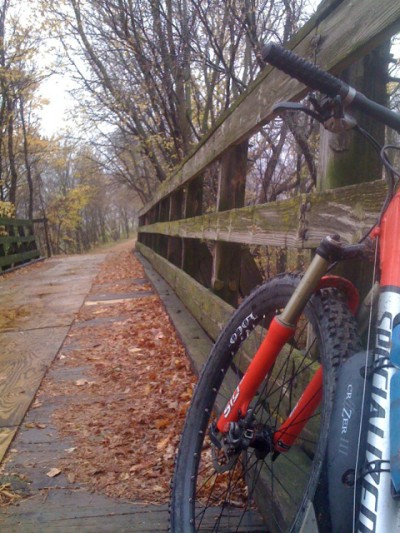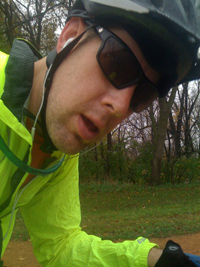
MINUS TEN
Often described as one of the toughest bike races in the lower 48 states, the Arrowhead 135 challenges even the most prepared riders. This is a journal by a non-athlete's participation in an event where starting is often just as much a challenge as finishing.

Stretching it out |
October 25, 2010 |

First, welcome to the new blog. I've been keeping notes on the prep for the Arrowhead, but not really in a public space. I moved the info out here to do a number of things. First, I've gained a lot of insight from reading other rider's Arrowhead blogs, so I thought it might be useful for someone in the future to see what I've been doing, and ultimately how that translates into performance. Secondly, my company, webExpeditions, is "sponsoring" my participation and this is another way for me to test out various technologies and ideas. It's a lot easier to see what works and what doesn't when using the system in a real-world way. Suprisingly enough, I don't use my own system that much. This will help me make improvements and try new ideas (like the facebook-driven comments).
So on my ride yesterday - which was long, gray and wet - I realized that there were three main components of the Arrowhead race that I need to train for: Weight, Difficulty and Distance, or WDD. They are like a triangle - all three are required to complete the object.
First, Weight: I've been looking at other people's snow bike weights, and 60+ pounds loaded weight is not uncommon. Now when you consider a "nice" bike is in the 20-25 pound range, and a "sweet" bike is sub-20, it makes you realize that training on a normal bike isn't going to cut it. Both of my bikes fall into the "nice" zone, so simply riding my bikes all day as-is isn't going to prepare me for riding one thats 3x heavier. So for that, I've added a BOB trailer (which has a single wheel) and have been gradually increasing the weight in it. The first time I took it out a few months ago the total weight of the trailer and cargo was about 15 pounds. I've increased that in several steps to where yesterday's ride was now up to a combined trailer weight of about 43 pounds. Add to that about 25 pounds of bike and I'm now in the proper weight zone for the race.

Difficulty is probably the hardest of the three to train for. Difficulty to me means the kind of terrain and surface that represents the race course. Finding something that accuratly represents a kind of hard-packed snow is tricky. Plus, its really hard to know exactly what you're going to get out there on race day: hard pack? fresh powder? soft mush? Most people feel that doing gravel riding is reasonable substitute until there is some snow, but switching to snow as soon as it's available will help. Combining that with hills and other uneven terrain will be important.
The last part is Distance. Pretty obvious, how far you have to go.
Distance + Difficulty means time, so what this really means is being able to stay on the bike at a certain level of output for enough time to get you the distance.
Some training for difficulty can also come from increased weight as well as interval training, because at the end of the day, weight and difficulty add up to strength. A big part of this is both strength and endurance training.
So yesterday's ride is getting closer. Weight, as I mentioned is at an acceptable level. I did 75 miles and nearly 7 hours, so this is beginning to approach required Distance and Weight. Next is to begin to increase the difficulty, which will also increase the total ride time. For this, I was eyeing the horse trail that runs along side of the bike path on the route I took yesterday. The horse trail is not level, and is not as smooth. The part that I'm curious about is in the winter, where to the snowmobiles go? Do they run the bike path or the horse path? (Once you get about 15 miles out west the trail is open to snowmobiles...)
As I mentioned, it was gray and wet, though not really raining. Just various degrees of fog and drizzle. The leaves where all mushy, and that made a lot of the trail soft and slippery. There was still pretty good color, though obviously past peak. I only saw a few other people on the trail all day. At one point I turned off the main trail and did some hills on a gravel road - I was getting bored with the flatness.

I stopped and ate about every 90 minutes, even though I never really felt hungry. Still working on neck and ass pain. My butt was pretty tender by the time I got home. I hate that saddle. Not going to really focus on these pains, however, until I get my new bike, hopefully in 4 weeks.
So on my ride yesterday - which was long, gray and wet - I realized that there were three main components of the Arrowhead race that I need to train for: Weight, Difficulty and Distance, or WDD. They are like a triangle - all three are required to complete the object.
First, Weight: I've been looking at other people's snow bike weights, and 60+ pounds loaded weight is not uncommon. Now when you consider a "nice" bike is in the 20-25 pound range, and a "sweet" bike is sub-20, it makes you realize that training on a normal bike isn't going to cut it. Both of my bikes fall into the "nice" zone, so simply riding my bikes all day as-is isn't going to prepare me for riding one thats 3x heavier. So for that, I've added a BOB trailer (which has a single wheel) and have been gradually increasing the weight in it. The first time I took it out a few months ago the total weight of the trailer and cargo was about 15 pounds. I've increased that in several steps to where yesterday's ride was now up to a combined trailer weight of about 43 pounds. Add to that about 25 pounds of bike and I'm now in the proper weight zone for the race.

Difficulty is probably the hardest of the three to train for. Difficulty to me means the kind of terrain and surface that represents the race course. Finding something that accuratly represents a kind of hard-packed snow is tricky. Plus, its really hard to know exactly what you're going to get out there on race day: hard pack? fresh powder? soft mush? Most people feel that doing gravel riding is reasonable substitute until there is some snow, but switching to snow as soon as it's available will help. Combining that with hills and other uneven terrain will be important.
The last part is Distance. Pretty obvious, how far you have to go.
Distance + Difficulty means time, so what this really means is being able to stay on the bike at a certain level of output for enough time to get you the distance.
Some training for difficulty can also come from increased weight as well as interval training, because at the end of the day, weight and difficulty add up to strength. A big part of this is both strength and endurance training.
So yesterday's ride is getting closer. Weight, as I mentioned is at an acceptable level. I did 75 miles and nearly 7 hours, so this is beginning to approach required Distance and Weight. Next is to begin to increase the difficulty, which will also increase the total ride time. For this, I was eyeing the horse trail that runs along side of the bike path on the route I took yesterday. The horse trail is not level, and is not as smooth. The part that I'm curious about is in the winter, where to the snowmobiles go? Do they run the bike path or the horse path? (Once you get about 15 miles out west the trail is open to snowmobiles...)
As I mentioned, it was gray and wet, though not really raining. Just various degrees of fog and drizzle. The leaves where all mushy, and that made a lot of the trail soft and slippery. There was still pretty good color, though obviously past peak. I only saw a few other people on the trail all day. At one point I turned off the main trail and did some hills on a gravel road - I was getting bored with the flatness.

I stopped and ate about every 90 minutes, even though I never really felt hungry. Still working on neck and ass pain. My butt was pretty tender by the time I got home. I hate that saddle. Not going to really focus on these pains, however, until I get my new bike, hopefully in 4 weeks.
© 2024
